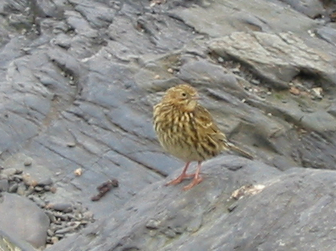South Georgia Pipit
It builds nests from dried grass, and lays four eggs a year. It lives off insects and spiders, and beach debris.

Original source: Ben Phalan, British Antarctic SurveyPermission(Reusing this file)I, the copyright holder of this work, hereby publish it under the following license: This file is licensed under the Creative Commons Attribution-Share Alike 3.0 Unported license.You are free:to share – to copy, distribute and transmit the work
Author: Ben Phalan, British Antarctic SurveyPermission(Reusing this file)I, the copyright holder of this work, hereby publish it under the following license: This file is licensed under the Creative Commons Attribution-Share Alike 3.0 Unported license.You are free:to share – to copy, distribute and transmit the work
The South Georgia Pipit is classified as Near Threatened (NT), is close to qualifying for or is likely to qualify for a threatened category in the near future.
The South Georgia Pipit (Anthus antarcticus) is a sparrow sized bird, only found on the South Georgia archipelago. It is the Antarctic's only song bird, and South Georgia's only passerine, and one of the few non-seabirds of the region. It builds nests from dried grass, and lays four eggs a year. It lives off insects and spiders, and beach debris. It has been threatened by the human introduction to the islands of rats, and also by environmental damage caused by humans themselves. More
South Georgia Pipit on Prion Islet, South Georgia South Georgia Pipit on Prion Islet, South Georgia South Georgia Pipit on Prion Islet, South Georgia Fortuna Bay, South Georgia Fortuna Bay, South Georgia Fortuna Bay, South Georgia Fortuna Bay, South Georgia More
region: the South Georgia pipit is Antarctica's only songbird, and the South Georgia pintail is the world's only meat-eating duck. More
South Georgia Pipit can be found in the rocks and cliffs of the seashore, whereas a number of species are restricted (for part of the year in some cases) to alpine areas. The family also ranges from the northern tundra and the subantarctic islands of New Zealand and the South Georgia group to the tropics. More
The South Georgia Pipit (Anthus antarcticus) is endemic to the island of South Georgia and the small surrounding islands. It is the only passerine that nests here. The pipit in the top three images was near a nest site in tussock grass on Prion Island, South Georgia, in January, 1996. The photographs were taken with a Canon T-90 & FD 400mm F/4.5 lens mounted on a tripod with Fuji Sensia 100 film. More
The endemic South Georgia Pipit is the only nesting landbird, and is found only on rat free islands. Wandering Albatrosses sometimes undergo incubation shifts lasting over a week. King Penguins greet us at Salisbury Plain, where Robert Cushman Murphy was an early visitor. It takes over a year to raise a chick, so there are always King Penguins ashore. More
South Georgia Pipit on the brink of extinction Antarctic Tern Antarctic Tern over Bird Island South Georgia Pintails The endemic South Georgia Pintail duck Project Director Tony Martin Project Director, SGHT Habitat Restoration Prof Tony Martin spacer spacer image More
South Georgia pipit and small petrels and the South Georgia pipit is absent from all rat infested areas. The eradication of rodents from South Georgia was identified as a high priority in the GSGSSI Plan for Progress. Over the last five years the South Georgia Heritage Trust have been developing plans and raising funds to undertake the eradication. The presence of glaciers on South Georgia, which isolate sections of the island, means that the eradication can be undertaken in stages. More
South Georgia Pipit, Prion Island, South Georgia 2/25/05 © John C. More
Family : Motacillidae
Genus : Anthus
Species : antarcticus
Authority : Cabanis, 1884

